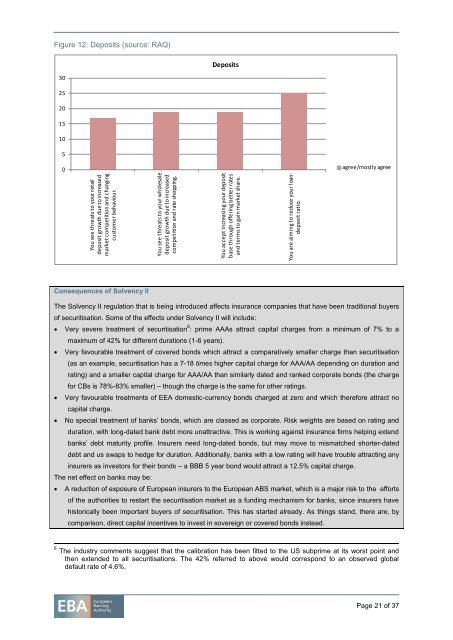EBA Long Report - European Banking Authority - Europa
EBA Long Report - European Banking Authority - Europa
EBA Long Report - European Banking Authority - Europa
You also want an ePaper? Increase the reach of your titles
YUMPU automatically turns print PDFs into web optimized ePapers that Google loves.
You see threats to your retail<br />
deposit growth due to increased<br />
market competition and changing<br />
customer behaviour.<br />
You see threats to your wholesale<br />
deposit growth due to increased<br />
competition and rate shopping.<br />
You accept increasing your deposit<br />
base through offering better rates<br />
and terms to gain market share.<br />
You are aiming to reduce your loandeposit<br />
ratio.<br />
Figure 12: Deposits (source: RAQ)<br />
Deposits<br />
30<br />
25<br />
20<br />
15<br />
10<br />
5<br />
0<br />
agree/mostly agree<br />
Consequences of Solvency II<br />
The Solvency II regulation that is being introduced affects insurance companies that have been traditional buyers<br />
of securitisation. Some of the effects under Solvency II will include:<br />
Very severe treatment of securitisation 6 : prime AAAs attract capital charges from a minimum of 7% to a<br />
maximum of 42% for different durations (1-6 years).<br />
Very favourable treatment of covered bonds which attract a comparatively smaller charge than securitisation<br />
(as an example, securitisation has a 7-18 times higher capital charge for AAA/AA depending on duration and<br />
rating) and a smaller capital charge for AAA/AA than similarly dated and ranked corporate bonds (the charge<br />
for CBs is 78%-83% smaller) – though the charge is the same for other ratings.<br />
Very favourable treatments of EEA domestic-currency bonds charged at zero and which therefore attract no<br />
capital charge.<br />
No special treatment of banks’ bonds, which are classed as corporate. Risk weights are based on rating and<br />
duration, with long-dated bank debt more unattractive. This is working against insurance firms helping extend<br />
banks’ debt maturity profile. Insurers need long-dated bonds, but may move to mismatched shorter-dated<br />
debt and us swaps to hedge for duration. Additionally, banks with a low rating will have trouble attracting any<br />
insurers as investors for their bonds – a BBB 5 year bond would attract a 12.5% capital charge.<br />
The net effect on banks may be:<br />
A reduction of exposure of <strong>European</strong> insurers to the <strong>European</strong> ABS market, which is a major risk to the efforts<br />
of the authorities to restart the securitisation market as a funding mechanism for banks, since insurers have<br />
historically been important buyers of securitisation. This has started already. As things stand, there are, by<br />
comparison, direct capital incentives to invest in sovereign or covered bonds instead.<br />
6 The industry comments suggest that the calibration has been fitted to the US subprime at its worst point and<br />
then extended to all securitisations. The 42% referred to above would correspond to an observed global<br />
default rate of 4.6%.<br />
Page 21 of 37
















